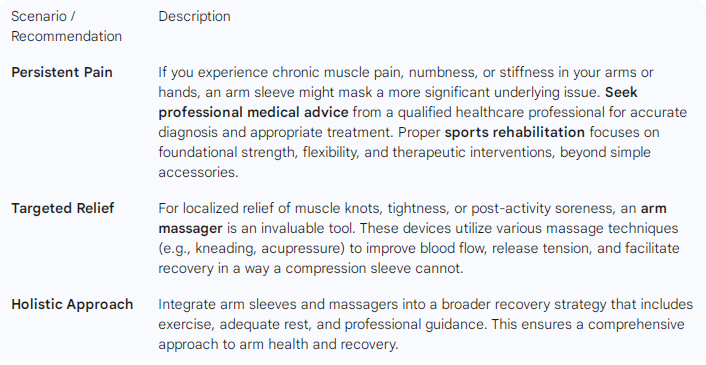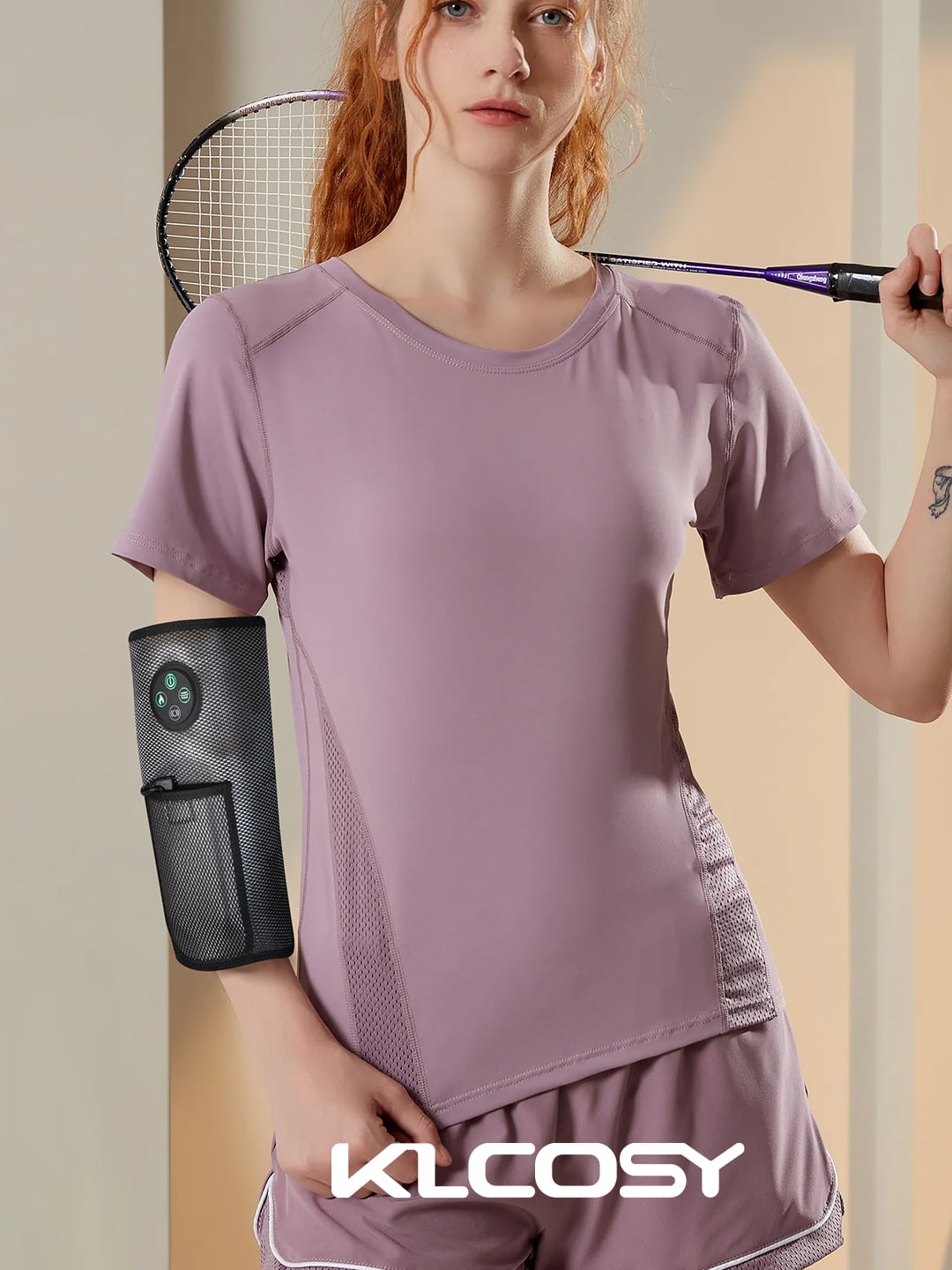Arm Massager for Golfers: Does it Heal Forearm Tendinitis?
- By Grace
- Updated on
arm sleeves are a common sight in sports, but their true benefits for athletic performance or sports rehabilitation are often debated. Are they a scientific aid or just a fashion trend? This article will explore the scientific evidence, psychological impact, and fashion appeal of arm sleeves to provide a balanced view for athletes and those in recovery, aiming to clarify their real effectiveness.
Understanding Arm Sleeves: More Than Just Fabric?
Arm sleeves are compression garments, usually made from synthetic, moisture-wicking fabrics, designed to fit snugly from wrist to bicep. Their use in sports evolved from medical applications where compression aided circulation and reduced swelling. Athletes adopted them, believing these benefits would translate to improved performance and faster recovery. While their design is simple, athletes' motivations for wearing them are complex, ranging from seeking a performance edge to achieving a uniform look, which is crucial for evaluating their impact in sports rehabilitation. Key claimed functionalities include compression for pressure, temperature regulation, UV protection, and abrasion protection.
The Science vs. The Sensation: Why the Debate Matters for Sports Rehabilitation
The effectiveness of arm sleeves is a debated topic in sports science. Proponents point to theoretical physiological benefits like improved circulation, reduced muscle oscillation, and faster lactic acid removal, which could enhance performance and recovery. These claims align with medical compression. However, consistent scientific proof directly linking general arm sleeves to significant performance gains in healthy athletes is still largely inconclusive, a critical point for sports rehabilitation which demands clear evidence for interventions.
Conversely, the psychological aspect is powerful. Even with minimal measurable physiological impact, the perception of support, muscle containment, or professional readiness can significantly boost an athlete's confidence—a potent placebo effect. When athletes believe they are better supported or recovering faster, they often perform better and feel less fatigued. As a physiotherapist, the influence of belief on recovery is evident, making this psychological element highly relevant for comprehensive sports rehabilitation strategies.
Understanding this duality—the gap between scientific proof and psychological experience—is crucial for athletes to set realistic expectations and wisely invest resources in tools that genuinely aid recovery and performance. Evaluating arm sleeves requires considering both their physical and mental aspects for a holistic understanding of their utility.
Arm Sleeves in Practice: Diverse Applications and Perceptions
For Muscle Recovery and Circulation: The Medical Angle
Many athletes use arm sleeves to help with muscle recovery and improve circulation after tough workouts or during competitions. The theory is that the gentle compression helps deoxygenated blood flow back to the heart more efficiently, reducing swelling and removing waste products like lactic acid. While more specific evidence for healthy arm recovery is still emerging, this concept is well-accepted in broader compression therapy. For those in sports rehabilitation, better circulation and less muscle soreness can significantly shorten recovery and allow for more consistent training.
Beyond compression, some arm sleeves feature moisture-wicking technology to keep skin dry and prevent chafing. For targeted muscle pain, like that from tennis or golfer's elbow, an arm massager can offer direct relief. These massagers use techniques like vibration, kneading, or air compression to boost local blood circulation and ease tightness, complementing the general support of an arm sleeve. While an arm massager isn't a direct treatment for carpal tunnel syndrome, it can help manage related muscle tension and improve hand and arm circulation, potentially easing some symptoms.
Choosing for Recovery: Look for graduated compression and moisture-wicking fabrics.
Complementary Therapies: Combine with stretches, foam rolling, or a dedicated arm massager for localized relief.
Post-Activity Use: Wear after exercise to aid recovery and reduce delayed onset muscle soreness (DOMS).
The Psychological Edge of Arm Sleeves
Arm sleeves offer significant psychological benefits for athletes, extending beyond just physical support. The snug fit often instills a "game face" mentality, fostering a tangible sense of readiness and confidence that can enhance focus, reduce anxiety, and help athletes feel "locked in." This belief in their gear can lead to real-world performance gains, a powerful dynamic also observed in sports rehabilitation. Additionally, the aesthetic appeal of arm sleeves, such as matching team colors or sleek designs, contributes to team cohesion and a professional appearance, further boosting an athlete's self-perception and confidence by blending fashion with function. These psychological advantages, like using the sleeve as a mental cue for focus and embracing its aesthetic as part of an athletic identity, provide a notable, even if not always physically measurable, confidence boost.
Beyond Performance: Arm Sleeves as a Fashion Statement
Undeniably, arm sleeves have carved out a significant niche as a fashion trend within the sports world. Their popularity is heavily influenced by professional athletes who wear them prominently, turning them into desirable accessories. Marketing campaigns by major sportswear brands further amplify this trend, positioning sleeves for arms not just as performance enhancers but as essential components of an athlete's stylish kit. This fusion of utility and style allows athletes to express individuality while adhering to team aesthetics, making them popular for casual wear and competitive sports alike. Think of **volleyball arm sleeves** – they serve a protective purpose, but their variety of colors and designs also makes them a fashion statement on the court.
The rise of custom arm sleeves highlights this trend, allowing teams and individuals to personalize their gear with specific colors, logos, or messages. This level of customization transforms a functional item into a personal statement, reinforcing team identity or celebrating individual achievements. While the primary objective of sports rehabilitation is about physical recovery, understanding the fashion element helps us grasp the full scope of why these sleeves are so prevalent. They are, in essence, a reflection of modern sports culture, where performance and personal style often go hand-in-hand.
- Influencer Marketing: Professional athletes drive popularity and desirability.
- Personal Expression: **Custom arm sleeves** allow for unique designs and team branding.
- Cultural Trend: They reflect a broader shift towards stylish athletic wear.

Maximizing Benefits: Tips for Choosing and Using Arm Sleeves
To truly get the most out of your arm sleeves, whether for perceived performance benefits or simply comfort, selecting the right product and using it correctly is crucial. The material composition greatly affects breathability, moisture-wicking capabilities, and durability, especially for those actively engaged in sports rehabilitation. Look for blends with a high percentage of spandex for good compression and recovery, combined with polyester or nylon for moisture management. The fit is paramount: an arms sleeve should be snug enough to provide compression without feeling restrictive or cutting off circulation. A sleeve that bunches or slides down will not offer any consistent benefit and can be a distraction during activity.
Proper care of your arm sleeve covers also extends their lifespan and maintains their effectiveness. Washing them according to the manufacturer's instructions, typically in cold water and air drying, helps preserve the elasticity and fabric integrity. Regular inspection for wear and tear is advisable, as stretched-out or damaged sleeves will lose their intended compression. While arm sleeves offer general support, remember they are not a substitute for proper injury prevention techniques, warm-ups, or professional medical advice if dealing with persistent pain or injuries like tendinitis. They are best viewed as a complementary tool in a broader strategy for athletic health and recovery.
- Material Matters: Opt for breathable, moisture-wicking fabrics with good elasticity.
- Achieve the Right Fit: Ensure a snug, comfortable fit that doesn't impede movement or circulation.
- Consistent Care: Follow washing instructions to maintain compression and durability of your arm sleeve covers.
When to Seek Alternatives or Professional Guidance for Arm Issues
While arm sleeves offer comfort and psychological benefits, it's crucial to understand their limitations, especially for persistent pain or specific injuries.

In conclusion, arm sleeves offer multifaceted benefits for sports rehabilitation and athletic performance, extending beyond mere fashion. Their advantages range from subtle physiological support through compression to a significant psychological boost and the expression of sports identity.
For athletes and those in recovery, maximizing the potential of arm sleeves involves choosing the right one, understanding its true capabilities, and knowing when to seek additional therapeutic support, such as an arm massager for specific issues.
Ultimately, arm sleeves can be a valuable addition to any active individual's gear. The key is an informed perspective, appreciating both their real and perceived advantages, and integrating them thoughtfully into a comprehensive approach to health, performance, and recovery. Sometimes, the belief in your gear, starting with a simple arm sleeve, can truly make a difference.





